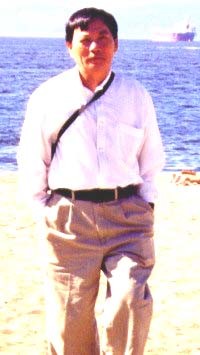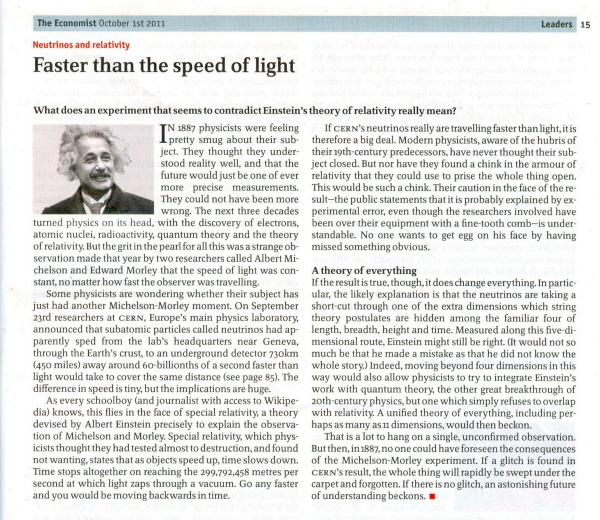 |
Was
Einstein
wrong?
 The 2011
Nobel prize for physics
Không biết năm
nay bọn “Mafia Do Thái” sẽ chọn nhà văn Nobel là ai, nhưng Nobel vật lý
thì quả
là Uỷ ban Nobel [không phải đám Mafia Do Thái nhe] đã đi guốc vào trong
“[Ðầu] Gấu”,
[Mafia với Ðầu Gấu thì cũng thế, tài hoa của NTHL Mít thì đâu có thua
gì tài
hoa của Nobel văn học Joseph Brodsky], khi ban cho mấy nhà vật lý thiên
văn, đúng
như tờ Người Kinh Tế phán
dưới đây. Lý do là, mấy ngày nay Gấu
cố tìm cách giới
thiệu thật gọn nhẹ nhà thiên văn thần kỳ, 1 trong 3 nhân vật thần kỳ
của cuốn Những Kẻ Mộng Du của Koestler, là Copernicus, Kepler và Galileo, nhân bài điểm
cuốn tiểu sử của Copernicus trên
tờ Người
Kinh Tế. Nếu đúng theo lịch trình
thì TV sẽ dịch bài điểm tiểu
sử Copernicus, cùng
lúc viết về Nobel vật lý năm nay, cùng lúc, giới thiệu cuốn Những Kẻ Mộng Du,
chương về Copernicus, và tất nhiên, về Einstein và câu hỏi nhức nhối: Was
Einstein
wrong? Liệu
Einstein đã lầm? THIS year's
Nobel prize for physics was awarded for what was, in a sense literally,
the
biggest discovery ever made in physics—that the universe is not only
expanding
(which had been known since the 1920s), but that the rate of expansion
is
increasing. Something, in other words, is actively pushing it apart. Nobel
vật lý năm nay được ban cho sự khám phá lớn lao nhất chưa từng có trước
đây, về
vật lý - rằng vũ trụ không chỉ nở mãi ra, điều này được biết từ 1920’s,
nhưng
mà cái mức độ nở của nó thì cứ tăng lên. Một điều gì đó, đang tích cực
đẩy nó
rã ra. Ui chao, “một điều gì đó”, chẳng lẽ là cái sự cũng “thường” thôi của sự triển nở của… Cái Ác Bắc Kít ? Vậy mà cứ cuống cuồng mãi lên! Zara NHT xuống
núi, chẳng đã phán Thượng Ðế đã chết, mà như Dos nói, nếu đếch có
Thượng Ðế thì
chuyện đéo gì cũng được phép. The
Economist October 1st 2011 Neutrinos
and relativity Faster than
the speed of light What does an
experiment that seems to contradict Einstein's theory of relativity
really
mean? IN 1887
physicists were feeling pretty smug about their subject. They thought
they understood
reality well, and that the future would just be one of ever more
precise
measurements. They could not have been more wrong. The next three
decades
turned physics on its head, with the discovery of electrons, atomic
nuclei,
radioactivity, quantum theory and the theory of relativity. But the
grit in the
pearl for all this was a strange observation made that year by two
researchers
called Albert Michelson and Edward Morley that the speed of light was
constant,
no matter how fast the observer was travelling. Some
physicists are wondering whether their subject has just had another
Michelson-Morley moment. On September 23rd researchers at CERN,
Europe's main
physics laboratory, announced that subatomic particles called neutrinos
had apparently
sped from the lab's headquarters near Geneva, through the Earth's
crust, to an
underground detector 730km (450 miles) away around 60-billionths of a
second
faster than light would take to cover the same distance (see page 85).
The
difference in speed is tiny, but the implications are huge. As every
schoolboy (and journalist with access to Wikipedia) knows, this flies
in the
face of special relativity, a theory devised by Albert Einstein
precisely to
explain the observation of Michelson and Morley. Special relativity,
which physicists
thought they had tested almost to destruction, and found not wanting,
states
that as objects speed up, time slows down. Time stops altogether on
reaching
the 299,792,458 meters per second at which light zaps through a vacuum.
Go any
faster and you would be moving backwards in time. If CERN'S
neutrinos really are travelling faster than light, it is therefore a
big deal.
Modern physicists, aware of the hubris of their 19th-century
predecessors, have
never thought their subject closed. But nor have they found a chink in
the armor
of relativity that they could use to pries the whole thing open. This
would be
such a chink. Their caution in the face of the result-the public
statements
that it is probably explained by experimental error, even though the
researchers involved have been over their equipment with a fine-tooth
comb-is understandable.
No one wants to get egg on his face by having missed something obvious.
A theory of
everything If the
result is true, though, it does change everything. In particular, the
likely
explanation is that the neutrinos are taking a short-cut through one of
the
extra dimensions which string theory postulates are hidden among the
familiar
four of length, breadth, height and time. Measured along this
five-dimensional
route, Einstein might still be right. (It would not so much be that he
made a
mistake as that he did not know the whole story.) Indeed, moving beyond
four
dimensions in this way would also allow physicists to try to integrate
Einstein's work with quantum theory, the other great breakthrough of
20th-century physics, but one which simply refuses to overlap with
relativity.
A unified theory of everything, including perhaps as many as 11
dimensions,
would then beckon. Lần đầu
tiên, Gấu biết tới Những Kẻ Mộng Du, 1959,
là đúng vào thời mê BHD, quen HPA, và cùng anh hay la cà mấy tiệm sách
cũ khu Chợ
Ðũi, Trần Quí Cáp, loanh quanh ngôi trường Kiến Thiết, nơi em học tiểu
học, cho
đến khi đậu vô trường Gia Long, và nhà rời từ đường Phan Ðình Phùng lên
đường Gia Long. Chính là 1
trong những lần lục sách báo cũ đó, Gấu vớ được 1 số báo nrf
điểm cuốn Những Kẻ Mộng
Du của Koestler, và không làm sao quên được sự chúc dữ của cái vòng
tròn, la malédiction du cercle, tức thời kỳ Koestler
gọi là Dark Interlude. Lịch sử lập lại: Cái sự say mê chủ nghĩa không tưởng Mạc xịt thì đâu có gì khác? Nhớ 1 lần ngồi Quán Chùa, nhắc tới Koestler, nhắc tới kỷ niệm trên, với ông anh nhà thơ. Hóa ra là ông cũng mê Koestler. Nhân đó, ông giới thiệu Gấu cuốn Le Cri d'Archimède, The Act of Creation, 1964, Hành động sáng tạo, của Koestler. Koestler viết:
Nhờ những cuộc cãi lộn về bản chất con người mà tôi viết ra được những
cuốn tiểu
thuyết. Những cuốn sách kia, là những toan tính của tôi, nhằm nghiên
cứu, cùng
một số phận về bản chất của con người, nhưng bằng những thuật ngữ khoa
học. Càng về già,
Gấu càng biết ơn Koestler, nhờ đọc Ðêm Giữa
Ban Ngày đúng vào lúc mới lớn, nói theo Applebaum, người viết Gulag Một Lịch Sử, nó giống như 1 thứ
thuốc chủng, nhờ vậy đã không lên rừng phò HPNT, những ngày ở Sài Gòn! |